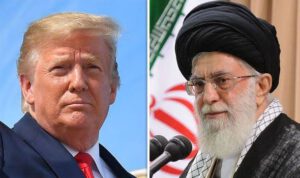
By Daniel Benjamin and Steven Simon (Foreign Affairs)
Imagine historians a century from now trying to decide which foreign power the United States feared most in the decades from the late Cold War through 2020. Sifting through the national security strategies of successive administrations, they would see Russia first as an arch-enemy of the United States, then as a friend, and finally as a challenging nuisance. They would see China transform from a sometime partner to a great-power rival. North Korea would appear as a sideshow.
Only one country would be depicted as a persistent and implacable foe: Iran. In its official rhetoric and strategic documents, Washington has, since Iran’s Islamic Revolution in 1979, consistently portrayed the country as a purely hostile and dangerous actor. In recent months, the United States and Iran have once again, as they have many times in the past, approached the brink of conflict: U.S. President Donald Trump has ripped up his predecessor’s nuclear deal with Iran and adopted a policy of “maximum pressure” to strangle the Iranian economy. Iran, meanwhile, has responded by heightening tensions, attacking several oil tankers traversing the Persian Gulf, shooting down a U.S. drone, and striking an oil facility in Abqaiq, Saudi Arabia.

No U.S. president has been as capricious as Trump, and there is a possibility that, after flirting with escalation, he will pivot toward an accommodation with Iran. (His recent dismissal of National Security Adviser John Bolton, an extreme Iran hawk, suggests that this process could already be underway.) But Trump’s approach during his first three years in office did not emerge from a void. It was an extension of the deep animus toward Iran that has plagued U.S. policymaking for the last 40 years. Previous administrations had balanced this hostility with pragmatism and periodic attempts at outreach, often cloaked in the language of confrontation; now, driven by greater political incentives and intensified lobbying by Israel and Saudi Arabia, Trump has inflated this animus to cartoonish proportions. In doing so, he runs the risk of a serious miscalculation. Iran is not an existential threat to the United States, but a serious conflict with it—at a time when Washington is threatened by great-power rivals and committed to drawing down its presence in the Middle East—would be costly and counterproductive.
Faced with the real prospect of a war that would benefit no one, it is time for the United States to rethink some of the assumptions that have led to the current impasse. It is time to relegate Iran’s remarkable grip on U.S. strategic thinking—call it “the Persian captivity”—to the dustbin.
A COUNTRY OR A CAUSE?
In balance-of-power terms, Washington’s obsession with Tehran is absurd. Iran’s population is one-fourth the size of the United States’, and its economy is barely two percent as large. The United States and its closest allies in the Middle East—Israel, Saudi Arabia, and the United Arab Emirates—together spend at least $750 billion annually on their armed forces, about 50 times as much as what Iran spends. Both Israel and the United States can produce state-of-the-art weapons, as well as reconnaissance, surveillance, and battle-management technologies. Iran cannot. Its industrial base is aged. Its air force and navy field outdated weapons systems. It possesses ballistic and cruise missiles and long-range drones that could strike Israel or the Gulf states, but it cannot use them without inviting devastating retaliation (although, admittedly, it appears to have run this risk with its September attacks on Saudi Aramco facilities).
In balance-of-power terms, Washington’s obsession with Tehran is absurd.
Despite Iran’s paltry conventional capabilities, U.S. policymakers—who have long sought to prevent any regional state from exercising hegemony in the Persian Gulf—have seen Iran as a threat for two interlocking reasons. The first is geography: Iran has a long shoreline on the Persian Gulf, through which about one-fifth of the world’s oil flows. In theory, it could attempt to block the flow of oil by closing the Strait of Hormuz, with potentially disastrous effects on the global economy. Yet practically speaking, this threat is remote. At no time in the last 40 years has Iran managed to close the strait, and even if it did, Iraq, Qatar, Saudi Arabia, and the United Arab Emirates could all use or develop alternative export routes. Iran could not.
The second cause for U.S. concern is Iran’s nuclear program. If Iran produced an atomic weapon, it could conceivably establish the regional hegemony that U.S. strategic doctrine seeks to prevent. A nuclear-armed Iran would revolutionize the strategic landscape in the Middle East and pose a significant threat to Israel, Washington’s closest ally in the region. Under U.S. President Barack Obama, the United States largely solved this problem with the 2015 nuclear deal, the Joint Comprehensive Plan of Action, which for all intents and purposes ended the country’s nuclear program for 15 years. In 2018, however, Trump withdrew from the JCPOA, arguing that a better agreement with Iran was possible. Since then, his administration has been using sanctions to try to force Iran’s leaders back to the negotiating table.
Much of the administration’s antipathy toward Iran is explained by what Secretary of State Mike Pompeo routinely refers to as Iran’s “malign activities”—its attempts to spread its influence across the Middle East through terrorism, political subversion, and assistance to Shiite groups. These activities are the reason why Iran is routinely (and deservedly) referred to as “the world’s foremost state sponsor of terrorism.” They are also, for Iran hawks, the best evidence that the country is still a revolutionary power dedicated to undermining the interests of the United States and its allies. For opponents of the JCPOA, including the Trump administration, the deal offered Iran tacit recognition as a legitimate interlocutor. Iran’s compliance with the deal, these opponents argued, was a cynical ploy to advance its expansionist objectives within the region. (This, of course, was a classic Catch-22: the hawks saw both compliance with the deal and any lack of compliance as evidence of Iran’s malign intentions.)

It is true that Iran has committed more than its share of atrocities. Yet it is no longer the same country that it was in the 1980s, when its revolutionary Islamist government really was bent on remaking the regional order. Iran’s support for terrorism, for example, has diminished substantially in the last 20 years. And although Tehran and its proxies still occasionally pull off a successful attack, such as the 2012 bus bombing in Burgas, Bulgaria, their attempts are of a smaller scale than before, and many of their recent plots have been absurdly ineffective. In 2011, for instance, an Iranian plot to assassinate the Saudi ambassador in Washington was doomed from the outset because the Iranian agent approached an informant for the Drug Enforcement Administration to carry out the killing. And in 2012, Iranian terrorists in Bangkok accidentally set off an explosion in their own safe house. When Thai police arrived at the scene, one of the Iranians threw a grenade—which hit a tree, bounced back at him, and blew off one of his legs.
All terrorism is bad, but the hawks exaggerate the threat posed by Iranian-sponsored terrorism, which is relatively lackluster compared with the jihadi terrorism that has at times been tolerated or even financed by Washington’s Sunni partners. Iran’s activities are less damaging to global stability than, say, Pakistan’s support for terrorist groups that target India or Russia’s annexation of Crimea, yet Washington treats Tehran as a pariah while preserving relations with Islamabad and Moscow. There is clearly something going on that transcends strategic interest.
The hawks exaggerate the threat posed by Iranian-sponsored terrorism.
One major caveat is that Iran supports the Lebanese terrorist group–cum–political party Hezbollah, whose large stockpile of missiles and rockets poses a serious threat to Israel. Yet Tehran’s motivations are as much geopolitical as ideological: the missiles are Iran’s main strategic deterrent against Israel. And this deterrence has generally prevailed since 2006, when it broke down through incompetence and misperception. The Israeli government has made it clear that if it ever has to fight another war with Hezbollah, it will invade Lebanon and leave only after it has destroyed Hezbollah and its armory. The situation is obviously delicate, but neither Israel nor Iran has an interest in upsetting the apple cart.

Aside from terrorism, many of Iran’s attempts to expand its reach throughout the Middle East should be seen for what they are: opportunistic responses to blunders by the United States and its partners. Hawks often warn of Iran’s influence in Iraq, for instance, but this is fundamentally a result of the U.S. invasion in 2003, which toppled Saddam Hussein’s Sunni minority government and empowered the country’s Shiite majority. Even with increased Iranian influence, moreover, successive governments in Baghdad have maintained good relations with both Tehran and Washington—indeed, the current government may be the most pro-U.S. Iraqi government yet. Iran’s backing of the regime of Syrian President Bashar al-Assad is an attempt to sustain the status quo—and defend a once reliable ally—after it was threatened by Sunni Arab states that were trying to overthrow Assad by arming and funding Syrian rebels. And Iran’s support for the Houthis in Yemen has been a largely convenient attempt to bleed its Saudi rivals dry.
The archrealist Henry Kissinger famously said that Iran must “decide whether it is a country or a cause.” The phrase has been invoked by much lazier strategists to justify a permanent hard line against Iran. After all, if your adversary is motivated primarily by ideology, then it is less likely to be open to compromise or accommodation. The problem is that this framing has blinded many American analysts to Iran’s real motivations: maximizing its security interests in a deeply hostile environment.
BAD BLOOD
The United States’ relations with Iran date back to World War II, when thousands of U.S. troops were deployed to Iran to secure a rail line essential to the year-round supply of the Soviet Union, then a U.S. ally. Although U.S. involvement in Iran remained limited in the early postwar period, Washington did participate as a junior partner in a British conspiracy to overthrow Iran’s elected prime minister, Mohammad Mosaddeq, in 1953. The overthrow of Mosaddeq was the original sin of the U.S.-Iranian relationship, and Iranian anger at the coup was later compounded by U.S. and Israeli support for Mohammad Reza Shah Pahlavi, whose repressive policies and inept attempts at modernization undermined popular support for his regime. The shah’s intimate relationship with the United States tainted both parties in the eyes of Iranians, contributing to the resentment that resulted in the Islamic Revolution of 1979.
The revolution marked a turning point. In late 1979, Iranian students stormed the U.S. embassy in Tehran and took its American staff hostage, leading U.S. President Jimmy Carter to sever diplomatic relations in April 1980. Soon, U.S. and Iranian interests were clashing across the Middle East. In 1980, Iraq attacked Iran; after repulsing this initial assault, in 1982, Iran invaded Iraq with the aim of overthrowing Saddam and spreading the Islamic revolution, sparking U.S. fears of Iranian hegemony in the Persian Gulf. In 1983, after a U.S. peacekeeping mission in Lebanon transformed into an intervention backing the country’s Christian government, Iran and Syria supported Lebanese Shiite militias that attacked American diplomats, military personnel, and intelligence officers. And although the United States, fearful that an Iraqi victory could lead Iran to turn to the Soviet Union for help, made efforts during the mid-1980s to back Tehran in the Iran-Iraq War, by the late 1980s, after the revelation of the Iran-contra scandal had rocked the Reagan administration, Washington had decisively thrown its support behind Baghdad.

Under Trump, the United States’ old hostility toward Iran has reemerged with a vengeance.
By the early 1990s, the United States had painted itself into a corner. Washington felt that it had to indefinitely suppress the ambitions of both Iran and Iraq, rather than use one to balance the other. Yet this policy proved unsustainable. After the United States demolished Saddam’s regime in 2003, it was left with an enemy, Iran, but no local partner to contain it. At the same time, the U.S. invasion of Iraq convinced Iranian leaders—now faced with U.S. troops on both their Afghan and their Iraqi borders—to take the opportunity to draw U.S. blood by transferring deadly explosive devices to Iraqi Shiite militias, further worsening relations between the countries. For a brief period during the Obama administration, the United States was able to use a combination of diplomacy and pressure to create space for the negotiation of the JCPOA. But under Trump, the United States’ old hostility has reemerged with a vengeance.
The durability of the United States’ 40-year obsession with Iran is remarkable. Consider that the United States fought and lost a decade long war in Vietnam that claimed more than 58,000 American lives, yet full diplomatic ties between Washington and Hanoi were reestablished in 1995, only two decades after the last helicopters left Saigon. Iranian misdeeds—above all, holding 52 U.S. diplomats and other citizens hostage for 444 days from 1979 to 1980—have certainly played a role. But the number of American deaths that can in any way be attributed to Iran since 1979 is shy of 500. On 12 occasions over the last 18 years, the polling organization Gallup has asked Americans the question, “What one country anywhere in the world do you consider to be the United States’ greatest enemy today?” Iran topped the list five times, ranking higher than China six times and higher than Russia eight times, despite not having nuclear weapons, a deep-water navy, or the ability to project power in any serious fashion.
How can this hostility be explained? One reason is that Iran fits neatly into a well-defined American idea of what a serious threat should look like. Similar to the Soviet Union during the Cold War, Iran has a revolutionary ideology, an expansionist orientation, and a network of allies around the world—in Iran’s case, the Shiite communities in the Middle East and in their diasporas in South America and West Africa. And until the U.S. invasion of Iraq, Iran had some success in cultivating its image as a global ideological power, posing as the leader of Muslim resistance to U.S. hegemony. With the fall of Saddam and the empowerment of Iraq’s Shiite community, however, the region’s Sunni rulers effectively recast the Iranian threat as a confessional one within the Islamic world. Instead of being seen as an anticolonial power, Iran became the leader of a “Shiite crescent” menacing the United States’ Sunni allies.
To make matters worse, the United States and Iran have dealt with each other in a dramatically different manner than the United States and the Soviet Union did. Cognizant of their respective nuclear arsenals and global reach, Washington and Moscow sought to stay engaged with each other and carefully avoided interfering with each other’s vital interests. Kissinger famously characterized the Soviet leadership as “essentially shits,” but that did not stop him—or other U.S. leaders—from interacting with them. By contrast, the United States has refused to engage with Iran, and the two countries’ relationship has been one of near-constant irritation and provocation.
If anything, U.S. antipathy toward Iran has grown more intense over the last two decades, even as Tehran has dialed back its revolutionary ambitions. This increased animus has coincided with both the rising influence of evangelical Christians within the Republican Party and the growth of public support for Israel in the United States. In 1989, Gallup found that 49 percent of Americans had a favorable overall view of Israel. Today, the figure stands at 69 percent. Pro-Israel sentiment has risen especially rapidly among conservative Republicans, reaching a peak of 87 percent last year. Democrats’ support has also grown, but currently sits at only 62 percent.
The distorting effect of Israeli influence on U.S. policy toward Iran has been especially pronounced since 2012. That year, the Republican candidate for president, Mitt Romney, seized the U.S.-Israeli relationship as a Republican asset, winning a quasi-official endorsement from Israeli Prime Minister Benjamin Netanyahu. Politicians and policymakers on both sides of the aisle rushed to outdo one another with displays of their commitment to helping Israel secure its interests. More recently, Saudi Crown Prince Mohammed bin Salman, who has not so discreetly aligned himself with Israel while also skillfully courting the Trump family, has turned Riyadh into a Republican asset, as well. To a greater extent than ever before, the United States under Trump has outsourced its Middle East policy to Israel and Saudi Arabia. In August, for instance, the Trump administration permitted Israel to carry out an airstrike in Iraq against an Iranian-allied militia—an action that clearly cut against the U.S. interest in Iraqi stability.
Everyone knows what a war in the Middle East would look like, and it is clearly best avoided.
For the United States, this hostility toward Iran is costly. For one thing, it increases the risk of armed conflict. It is both true and fortunate that since 1987–88, when U.S. and Iranian ships clashed in the waters of the Persian Gulf, the two countries have avoided open hostilities. But the current proximity of U.S. and Iranian forces, the countries’ history of sustained antagonism, and their leaders’ tendency to see each other as locked in a zero-sum struggle all heighten the risk of conflict. The absence of diplomatic ties and other communication channels makes confrontations even more likely to escalate. Everyone knows what a major U.S. war in the Middle East would look like, and it is clearly best avoided.
The current U.S. approach to Iran also risks driving a wedge between the United States and Europe. Although the Europeans have no great love for the Iranian regime, they prefer negotiation to conflict. They are particularly proud of having helped author the JCPOA, which, apart from its other virtues, was a masterpiece of complex diplomatic coordination. The transatlantic disconnect on Iran reaches back at least to the administration of U.S. President Bill Clinton, when Congress voted to impose sanctions on European companies selling equipment to Iran’s oil industry. But it has intensified under Trump. The transatlantic alliance may not have the same profound strategic importance that it did during the Cold War, but in an era when both China and Russia are challenging the West, it is nonetheless vital. Allowing Iran to become a sore point between the United States and Europe would be staggeringly imprudent.
Finally, U.S.-Iranian antipathy poses a threat to regional stability. The majority of states in the Middle East are fragile; in the past decade alone, two, Libya and Yemen, have collapsed, and one, Syria, has come close. The economic, political, and environmental strains on the region will only increase over the coming years. For most states, with the exception of a few oil monarchies, there is little prospect of relief. The United States has an interest in helping these countries hold together. But its campaign of maximum pressure on Iran, which is intended to bankrupt the regime and foster revolutionary conditions, runs precisely counter to this interest. However distasteful the current government in Tehran may be, the consequences of state collapse in Iran—including a likely refugee crisis and enormous strains on neighboring countries—would be even worse.
WE CAN WORK IT OUT
Washington and Tehran have rarely gotten along. Yet Trump’s blanket hostility toward Iran represents a departure from the norm of previous presidents. From the time of the Islamic Revolution, successive U.S. administrations have had an ambivalent relationship with Iran. Publicly, they have often taken a hard line, suggesting that the country harbors an immutable enmity for the United States. In private, however, both Democratic and Republican administrations have sought a more pragmatic approach. None, prior to the Trump administration, has consistently taken the position that a working relationship with the clerical regime is beyond the pale.
This split between public and private approaches began under Carter. After the shah fled Iran in January 1979 and requested entry into the United States for medical care, Carter waffled for months before finally admitting him in October, against the advice of his ambassador in Tehran. Behind the scenes, the CIA continued to provide the new Iranian government with sensitive intelligence until November 1979, when Islamist students, outraged at Carter’s decision, seized the U.S. embassy in Tehran. It was only the hostage crisis, followed by a botched U.S. attempt to rescue the hostages in 1980, that finally convinced Carter that the revolution had damaged U.S.-Iranian ties beyond repair.
Even President Ronald Reagan, canonized for his moral clarity, was willing to work with Iran when it was convenient. During Reagan’s first year and a half in office, the United States allowed Israel to send Iran a vast quantity of American-made weapons to aid in the war against Saddam. Despite the fact that Iran and Syria colluded in separate attacks in 1983 against the U.S. embassy and a U.S. Marine barracks in Beirut, killing 17 embassy personnel and 241 U.S. troops, Reagan never retaliated. By his second term, he was once again looking for an opening to Iran. His administration had two main reasons for resuming ties: it needed Iran’s help to free U.S. hostages held by Iranian proxies in Lebanon, and it wanted to increase U.S. leverage in Tehran at a time when it seemed as if the Soviets might try to ingratiate themselves with the clerical regime. In 1985, the United States resumed selling military equipment to Iran via Israeli intermediaries, an operation that continued for over a year, until it was exposed by a Lebanese newspaper. The revelation of these sales nearly destroyed Reagan’s presidency—especially once it emerged that the National Security Council staffer Oliver North had used money from the sales to illegally fund the Nicaraguan contras.
The usual story about the Iran-contra scandal is that Reagan was desperately concerned about the U.S. hostages in Lebanon, but it may be closer to the truth to say that Reagan’s approach to Iran paralleled his approach to the Soviet Union. He believed that both regimes were unsustainable and that the best way to hasten their demise was through dialogue backed by military strength. His problem, of course, was that Iran had no Mikhail Gorbachev, the reformist Soviet premier who became Reagan’s negotiating partner.
Although U.S. Iran policy fell into a lull under President George H. W. Bush, it resumed under his successor, Clinton. After Washington tightened sanctions, Iran orchestrated the 1996 bombing of the Khobar Towers complex, in Saudi Arabia, then in use by American military personnel enforcing a no-fly zone over Iraq. Nineteen members of the U.S. Air Force were killed. (As it has under Trump, American pressure invited an Iranian response.) Yet by the time blame for the attack could be authoritatively pinned on Iran, in 1997, retaliation had lost its attraction—all the more so since Mohammad Khatami, who had pledged to end Iran’s provocative foreign policy, had been elected president in the interim. Clinton moved swiftly to capitalize on Khatami’s reform program but had little leeway to reduce the congressionally mandated sanctions, an Iranian sine qua non for meaningful diplomatic progress. What might have been an opportunity to normalize the bilateral relationship fizzled.
The failures of U.S.-Iranian rapprochement cannot be laid solely at the feet of Washington.
President George W. Bush never really had chance to implement an Iran policy before the 9/11 attacks derailed his plans. Once Bush regained his balance, however, the United States and Iran cooperated closely in Afghanistan following the 2001 U.S. invasion. But in May 2003, U.S. intelligence intercepted a congratulatory message from al Qaeda militants under house arrest in Iran to the terrorists who had assaulted a housing compound in Riyadh. Bush promptly shut down U.S. cooperation with Iran in Afghanistan, Iran began shipping weapons to Shiite insurgents in Iraq, and the chance for cooperation vanished.
The failures of U.S.-Iranian rapprochement cannot be laid solely at the feet of Washington, of course. Since 1979, Iran has often gone out of its way to foment tension. Tehran and its proxies have carried out assassinations, kidnappings, and terrorist attacks against Americans and U.S. allies. The clerical regime has made anti-Americanism a core component of its ideology and public rhetoric. And although elements of the Iranian leadership have long favored détente, powerful constituencies within Tehran—including hard-line clerics and the Islamic Revolutionary Guard Corps—have time and again sought to scuttle efforts at diplomatic outreach.
The Obama administration, however, demonstrated that Tehran’s belligerence need not be an unsurmountable obstacle to progress. Like Clinton, Obama entered office determined to get tough on Iran. During his first term, he used his credibility with the Europeans to expand multilateral sanctions on Iran, hoping to force Tehran to negotiate over its nuclear weapons program. Then, Iranian presidential elections in 2013 replaced the incendiary Mahmoud Ahmadinejad with Hassan Rouhani, a Western-educated cleric who was willing to exchange a long-term freeze on Iran’s nuclear weapons program for relief from U.S. sanctions. The resulting agreement, the JCPOA, was narrowly focused on the nuclear issue: it was not intended by either side to resolve the myriad other impediments to U.S.-Iranian reconciliation. But many supporters of the deal thought that the successful negotiation of such a complex agreement would set a useful precedent, allowing for future dialogue on other issues. After bringing maximal multilateral pressure on Iran in his first term, Obama left office having laid the groundwork for improved relations.
GETTING BACK TO NORMAL
There are, to be sure, flickering signals that Trump will end up conforming to the established pattern on Iran, striving to seem tough in public while seeking a private accommodation. His decision not to retaliate against Iran’s downing of an American drone in June, his efforts to arrange a phone call with Rouhani, and his recent firing of Bolton all point in this direction. But such an about-face is unlikely. Trump’s Republican backers, both in and out of Congress, still support a hard line against Tehran, and the Iranians will be doubtful that Trump can be trusted to stick with any deal. He will likely leave office as determined to subjugate Iran as he was on entering it.
Yet the United States—if not under Trump, then under his successor—has a compelling interest in finding a modus vivendi with Iran, just as it repeatedly sought to do with the Soviet Union during the Cold War. Washington’s most important goal should be to prevent Iran from acquiring nuclear weapons—a development that could destabilize the entire Middle East. The most effective way to do this is through multilateral diplomacy along the lines of the JCPOA. This would not only provide for an inspections regime that would augment Western intelligence gathering but also create incentives for Iranian cooperation; by contrast, a confrontational approach will strengthen Iran’s hard-liners and produce perpetual incentives for Iran to cheat. Finding a workable arrangement, however, will require bold diplomacy by a future Democratic administration, which will need to overcome the objections of both the Republican Party and an Israeli government that—regardless of the party in office—will want to use U.S. power to beat Iran into submission.
The next administration should, at long last, give sustained engagement a try.
A second U.S. goal must be to gain some leverage over Iranian foreign policy in order to reduce the likelihood of a conflict between Washington and Tehran. This is easier said than done, since a U.S. administration would have to simultaneously reach out to the Iranians and mitigate the anxieties of U.S. allies. It will also be challenging because of potential spoilers on the Iranian side—namely, the hard-liners who have on several occasions blocked rapprochement. At a minimum, gaining meaningful influence over Iranian policymaking would require opening a military-to-military channel of communication with Iran, with the initial goal of preventing accidental clashes. That link could then progress to quiet multilateral talks on technical questions, move on to higher-level political discussions regarding areas of potential cooperation, and finally culminate in diplomatic normalization.
Only when the U.S. embassy reopens in Tehran will there be enough regular, businesslike interactions between the two sides for the United States to influence Iranian decision-making. Now that the war in Syria is effectively over, deterrence is holding on the Israeli-Lebanese border, Israel has demonstrated its resolve in preventing Iran’s entrenchment near the Golan Heights, and the United Arab Emirates has walked away from the Saudi war in Yemen, there is an opportunity for cautious movement. Trump is unlikely to grasp it, largely because the perceived political cost is too high. But the next administration should, at long last, give sustained engagement a try (Courtesy: Foreign Affairs)









